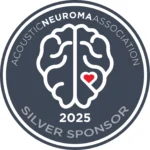- PATIENT FORMS | REQUEST A CONSULTATION | CONTACT US
- 1-844-NSPC-DOC
Acoustic Neuroma
What Is an Acoustic Neuroma?
Take ActionAn acoustic neuroma is a benign tumor that develops on the cranial nerve connecting the ear to the brain. Also called a vestibular schwannoma, it develops from the overproduction of Schwann cells that form the myelin sheath on the eighth cranial nerve.
Acoustic Neuroma Symptoms
The tumor usually grows slowly. As it develops, it presses against the hearing and balance nerves. At first, you may have no symptoms or only mild symptoms. Acoustic neuroma symptoms can include:
- Decreased or muffled hearing on one side
- Fullness or ringing in your ears
- Dizziness
- Balance problems
- Numbness or paralysis of your face
It can be hard to diagnose acoustic neuroma; ear exams and hearing tests may not show if you have it because acoustic neuroma symptoms are similar to those of middle ear problems.

Acoustic Neuroma Treatments
Long Island neurosurgeon Dr. Michael Brisman discusses how new technologies and advancements have improved Acoustic Neuroma treatments.
Not all acoustic neuromas need acoustic neuroma surgery. A patient’s age, condition and symptoms are all evaluated to determine the best course of action. If the tumor stays small, you may only need to have it checked regularly with MRIs and exams. However, hearing can deteriorate rapidly and suddenly, so you may want to treat the tumor while it is still easily managed with stereotactic radiosurgery. If it continues to grow, it could put pressure on the brain and become life-threatening.
Suboccipital Craniectomy or Translabyrinthine Surgery for Acoustic Neuroma
For patients who have a complete hearing loss, who wish to avoid radiation therapy or who are not good candidates for Gamma Knife radiosurgery, a craniectomy may be the best option.
The Suboccipital Craniotomy or retrosigmoid surgery involves removing part of the occipital bone behind the ear to access the tumor. This procedure is performed under general anesthesia and requires a hospital stay.
Because the mastoid bone and the balance canal structures of the inner ear are removed during translabyrinthine surgery, this approach is only appropriate for patients who have no usable hearing. This technique requires almost no retraction of the brain in order to expose the tumor.
Gamma Knife Radiosurgery for Acoustic Neuroma
The Long Island Gamma Knife Center offers a noninvasive acoustic neuroma surgery alternative to major open surgery.
When radiation or surgery is the best course of treatment, it has a greater than 95% success rate. Gamma Knife Radiosurgery, a type of stereotactic radiosurgery (radiation therapy using precise coordinates from computer imaging), is one such technique that is proving to be particularly beneficial for treating acoustic neuromas. Using radiation beams, Gamma Knife Radiosurgery offers a single-session brain surgery that is bloodless and highly effective. In most cases, patients are discharged on the day of radiation therapy.
At NSPC, we’re proud to offer the latest neurosurgical techniques that provide faster recoveries and better outcomes for our patients. Our expert neurosurgeons are experienced in providing an individualized acoustic neuroma treatment for each patient. We offer leading-edge treatments for brain and spine conditions, in the New York area.

Related NSPC Center
Long Island Brain and Spine Tumor Center
NSPC provides state-of-the-art treatment of benign and malignant brain and spine tumors, using minimally invasive procedures like Gamma Knife®, Novalis TX™, and CyberKnife® rather than major surgery whenever appropriate. Our physicians also perform experienced pediatric neurosurgery — they give personalized, individual attention combined with knowledge and experience to take on the most challenging of cases.
Neurosurgeon, Dr. Michael Brisman, has a passion for helping patients find innovative solutions for their acoustic neuromas. He has successfully treated hundreds of Acoustic Neuroma patients during the 23 years he’s been in practice on Long Island in New York. During this presentation, he discusses the presentation and diagnosis of acoustic neuroma, including tumor anatomy, as well as available treatment options, including observation, surgery, and radiosurgery. Dr. Brisman’s presentation includes a focus on stereotactic radiosurgery and a Q&A period following the discussion.
Physicians
Connect With Our 7 Convenient Locations
across Long Island, NY
Our expert physicians, surgeons and doctors are ready to serve you at our 7 convenient locations across Long Island, NY. Connect today to learn how our award winning, world class experts can help.
4250 Hempstead Turnpike Suite 4,
Bethpage, NY 11714
(516) 605-2720
COMMACK
353 Veterans Memorial Hwy,
Commack, NY 11725
(631) 864-3900
One Hollow Lane, Suite 212
Lake Success, NY 11042
(516) 442-2250
MANHATTAN
215 E. 77th Street Ground Floor
New York, NY 10075
(646) 809-4719
EAST SETAUKET
226 North Belle Mead Road, Suite C
East Setauket, NY 11733
(631) 828-3001
100 Merrick Road, Suite 128W
Rockville Centre, NY 11570
(516) 255-9031
WEST ISLIP
500 Montauk Hwy
West Islip, NY 11795
(631) 983-8400
World
Class
Expertise
For over 50 years & 350,000 patients NSPC has been a trusted global medical leader.
Contact us today for an appointment or consultation.


